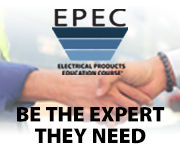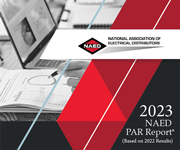By Urvashi Verma
The LED market has rapidly matured in a way not seen with other lighting products. It also holds great promise as a tool for manufacturers and end-users to take advantage of its benefits, including long lifetimes and consistent output, for applications well beyond outdoor and indoor lighting. We recently spoke with Amy Huntington, CEO of Market Group Americas at Philips Lighting, and Rick Edens, President of QSSI about the challenges and opportunities provided by solid-state lighting at this still-early stage of adoption and usage.
Q&A with Philips’ Amy Huntington:

lightED: Has the explosion of the lighting market in recent years surpassed your expectations?
Huntington: Absolutely, but not just in the volume of activity, also in regard to the growing acknowledgment of lighting as a strategically important “spend” within an organization. It is no longer a routine purchase with decision-making residing in solely maintenance or procurement functions. The shift to connected lighting systems and services is opening up the door to new opportunities where lighting is truly providing value beyond illumination.
There has never been a more exciting time to be part of the lighting industry. We have seen an unprecedented growth in our light-emitting diode business across all categories (lamps, retrofit kits, and fixtures), while our continued advancements in LED technology are significantly enhancing energy efficiency, design, and the lifetime of our products. The next frontier, digital, will accelerate as customers truly understand the new use cases for light and bottom line impact.
lightED: What will be the key drivers in the US lighting market in the near-term (between now and 2020)?
Huntington: There are two significant trends driving the lighting industry’s growth.
The first is increasing demand for more energy efficient light. According to the US Energy Information Association, lighting accounts for 10 percent of total electricity consumption in the U.S. Switching to LED enables light-related energy savings up to 50 percent—and that number jumps to 80 percent when paired with smart controls.
Despite this, a significant portion of light points in the U.S. remains to be converted to LED representing a tremendous retrofit opportunity. By offering distributors a full range of LED options—like our InstantFit LED lamps, EvoKit LED troffers, or industry-leading portfolio of integrated LED luminaires—we’re ideally positioned to meet the needs for renovation, new construction, or any type of space improvement/optimization projects.
The second is the continuing growth and adoption of lighting systems and services that take advantage of the increasing potential of digital light. Lighting is ubiquitous, reliable and a “powered” fixture everywhere that people live, work, travel, shop, dine and interact. Digital communications and energy-efficient LED lighting is revolutionizing the lighting infrastructures already in place. From cities and stores to offices and homes, lighting systems are being transformed into information pathways with the capacity to collect and share data and offer new insights that enable, and really drive, the Internet of Things. These lighting systems become a conduit to exciting new services enabled by data that can increase operational efficiency, enhance productivity and deliver value in new ways.
lightED: What does the future hold for light and connectivity?
Huntington: Connectivity will continue to become more mainstream as technology evolves and volumes drive costs down. Simple control solutions, like our Instantfit, LED lamps with EasySmart, are now available, requiring nothing more than a lamp change and an easy-to-use app to allow for immediate control of the lighting in a space. Retrofit kits and fixtures are also available with control solutions already embedded within them, making the change to connected lighting ubiquitous with the upgrade of any light point. Innovation in affordable and easy-to-install controllable solutions will continue to enable this trend. We’ve set an ambitious goal that all of our light points will be connected or connectable by 2020.
The public lighting market is a great example of growth potential for connectivity. Globally, just 2 percent of installed street lighting systems are connected today, but this number is set to reach 35 percent by 2025, according to a recent market analysis from Philips Lighting. This represents a huge growth opportunity for connected lighting systems and services as adoption continues to proliferate.
In commercial buildings, connected lighting systems have the capacity to collect, share and analyze data that offer insights into new capabilities such as space optimization and employee experience. With technology that exists today, every fixture in a building is capable of producing better light, using less energy, while providing smart insights designed to improve the comfort, utilization, and attractiveness of a workspace. If we imagine that every light is equipped with a sensor that can collect all kinds of data points about the office environment and its uses, there is so much more value that a building can afford its tenants beyond illumination.
lightED: How will distributors play a role in the future of lighting sales?
Huntington: As lighting solutions evolve, distributors will continue to generate and fulfill demand through local stock and provide a variety of value-added services to facilitate their customers’ projects.
The cycle of product innovation is now more rapid and robust, which is true for luminaires and LED lamps alike. We are working directly with distributors to keep up with the accelerated pace of innovation and act as a critical point of reference to bring new and continuously changing lighting solutions to their customers. In fact, we can stimulate demand beyond traditional new construction and scheduled replacement/renovation events which are of great value for our customers. As a manufacturer, we need to ensure backward and forward compatibility, develop training materials for our partners, and support the challenges associated with phase in/phase out.
lightED: How can distributors build a stronger relationship with designers and contractors to use the best light in the correct situations?
Huntington: Now more than ever, collaboration among distributors, designers, contractors, and manufacturers is essential. Distributors can act as an expert in helping designers and contractors to select the right products to meet their application and project needs.
While many of the conventional communications channels between these groups remain important, digital tools are no longer the exception, but the expected. Distributors that are able to leverage digital tools effectively will be able to unlock significant growth opportunities from more efficient sales processes to support marketing and demand generation.
For example, as people, in general, have become more accustomed to shopping and transacting online and via mobile phones, there is an opportunity to provide these conveniences to contractors who find value in going online to see what’s in stock and buy during off-hours or directly while on a job site.
lightED: How will price impact the future of lighting?
Huntington: Converting from traditional incandescent lighting to LED is commonly understood to greatly reduce energy consumption and costs. For the last few years, we have seen rapid cost/price improvement that has sparked a competitive intensity not seen in many other industries. However, we will reach a point where this begins to stabilize and the product features, quality, and expertise of the sales effort will be the biggest differentiators. Teams able to articulate the added value of LED beyond just energy savings will win opportunity and justify price aligned with value.
lightED: What do you think the capabilities of light may one day become?
Huntington: In today’s digital age, lighting is being redefined. It’s no longer just about illuminating and switching your light switch on and off. It’s about connecting, responding and transforming. We are at the forefront of this wave of innovation and we’re developing technologies and systems that are changing how people see and experience their world. This includes making people’s lives more safe, inspired, and comfortable, making businesses more productive and profitable, making cities more efficient and livable and making the world more sustainable and prosperous.
Q&A with QSSI’s Rick Edens:
lightED: Has the explosion of the lighting market in recent years surpassed your expectations?
Edens: I feel the industry was prepared for an upswing caused by energy-saving retrofitting, but it has indeed exceeded anticipation. The retrofitting pertains to both indoor and outdoor lighting. The demand for LED lighting was near instant, which surprised many, especially the commercial and industrial sectors.
lightED: What will be the key drivers in the US lighting market between now and 2020?
Edens: There are several key drivers. The first is proper education about LED lighting and its true longevity, optical performance, and thermal management. It’s important to understand LED’s true value proposition. A cheap LED luminaire portends product issues.
There has been a realization that lighting replacement costs in the commercial and industrial sector are substantial due to typical heights utilized and the type of mounting required.
The lack of monitoring systems to act as a check & balance for certified products to ensure that the performance being delivered is that which was certified is another.
lightED: What impact will international markets have on the lighting industry in the upcoming years?
Edens: The impact on the international markets to expand lighting sales is very optimistic due to the worldwide demand for LED lighting and similar standards in product specifications requirements internationally. Electronic solid state lighting offers a broad incoming voltage range from 120-277v and 347-480v thus allowing sales into nearly all international markets.
LED-dedicated product designs are now by nature appealing to nearly all international markets as compared to before, where the U.S. market demanded larger luminaires than other markets.
Additionally, we must consider the impact of Asia manufacturers on international markets as they now pose more competition for all markets.
Local manufacturers can increase market share and have the ability to design and produce LED luminaires specific to their market without concern of having to use a particular lamp and power supply.
They can easily create and enhance their local platforms.
lightED: What does the future hold for light and connectivity?
Edens: The future should remain very optimistic with opportunities for connectivity and utilization of lighting for additional services. Simple lighting controls via connectivity are extremely popular and should become a part of every LED luminaire installed.
New construction would also impact the future if it increased to the level it is needed.
lightED: How will distributors play a role in the future of lighting sales?
Edens: Distributors should continue to play a significant role as they enhance services, cooperation with lighting manufacturers, education of sales and support staff and establish energy departments.
lightED: What changes can distributors make to maintain a competitive edge?
Edens: I feel distributors can maintain a competitive edge by offering products which best suit the opportunity at hand on a job-by-job basis. They must open their minds on product-sourcing and create alliances with other manufacturers that may not have been a supplier in the past.
Maintaining a competitive edge is not just about price, but the best value. Distributors should consider true product specifications, reliability in meeting warranty claims, lead times, components used within the luminaire, before and after service levels and a final cost based on value and fit for a particular application.
Distributors can also create additional value for their customers by providing a complete package of electrical and lighting products.
lightED: How can distributors build a stronger relationship with designers and contractors to use the best light in the correct situations?
Edens: Distributors must target and actively pursue designers as well as contractors and facilitate the sale. Their sales strategy must be education-based so that true light solutions can be presented and sold.
They should establish in-house testing facilities and conduct proper product evaluations to better understand their lighting products and expectations.
Testing could simply be thermal and basic electrical testing but could also include photometric testing via third-party.
It’s important for both contractors and designers to understand these factors and endorse products with conviction, especially those which carry an extended warranty, such as LED lighting.
lightED: How will price impact the future of lighting?
Edens: It is currently playing havoc in the industry, especially for U.S. manufacturers whose primary goal has been to produce a product which is truly warranty worthy.
A day of reckoning may come on cheap LED products and could force education on how to manufacture and procure quality LED products based on value and not lowest cost.
There is no ANSI standard for LED boards used in luminaires and therefore the platform has many variations, creating an opportunity to design and produce based on performance and longevity.
lightED: What do you think the capabilities of light may one day become?
Edens: What we now know is that LED lighting has proven energy savings, good light control when designed properly, defined light patterns and distributions, a range of color temperatures (CCT) are available and an extended life as compared to legacy lighting. We have the ability to control LED lighting via on-off instantly, dimming and easy integration for motion and daylight harvesting,
Capabilities such as security monitoring and communication facilitation are underway, while others are surely forthcoming.
Tagged with Exclusive Feature, lighting, Philips, QSSI






